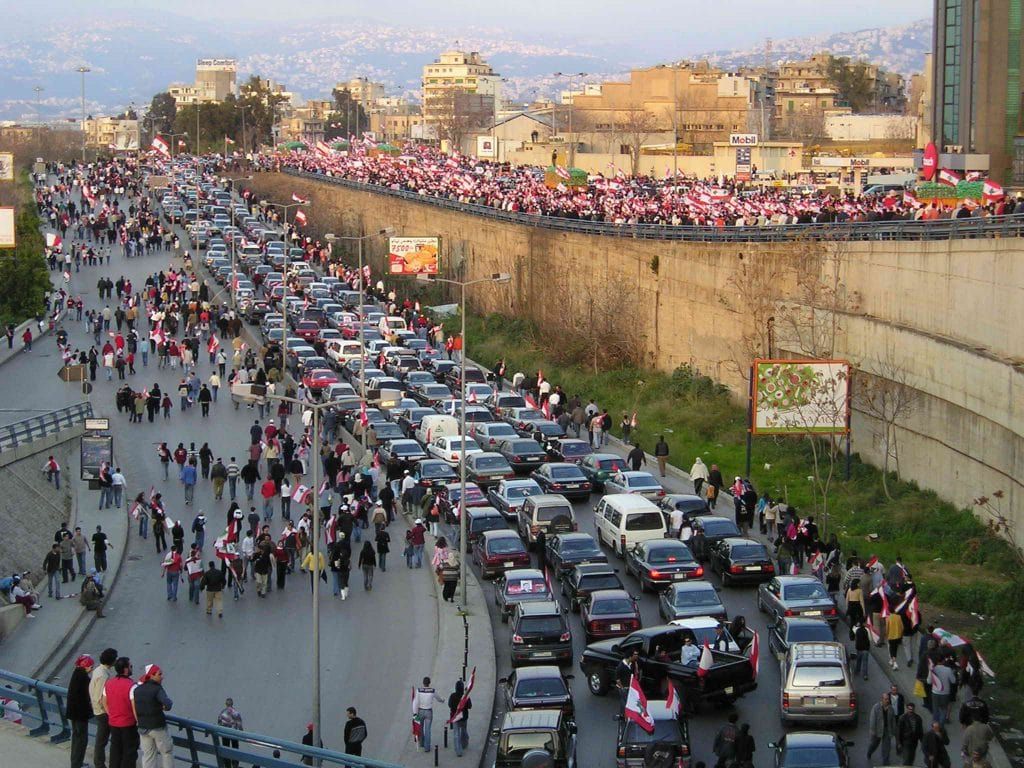Today, September 1, marks 100 years of Lebanese independence. Unfortunately, over the course of its existence, Lebanon has rarely been a calm place. To mark the occasion, a piece by Associated Press writer Bassem Mroue summarizes 100 of years of Lebanese turmoil — but manages to whitewash years of violence against Israel.
Join the fight for Israel’s fair coverage in the news
Hezbollah’s origins, sanitized
One might think that in a piece about a century of violence, the rise of the infamous Hezbollah terror group would merit at least a paragraph. Sadly not, but Mroue does have space for the following, rather vague, line:
Israel’s 1982 invasion and the attacks on the Americans marked the rise of what later became the militant group Hezbollah.”
So the history of Hezbollah’s establishment is not mentioned, but there is space to claim it ostensibly arose to oppose Israel’s invasion of Lebanon? Of course, that was only ever part of the story.
Hezbollah, literally meaning Party of God, always had a much more grandiose vision than simply defeating Israel in Lebanon. Established in the early 1980s, Hezbollah was largely formed with the aid of the Ayatollah Khomeini’s followers in order to spread Islamic revolution and establish an Islamic republic in Lebanon. Describing Hezbollah in terms of pushing Israel out of Lebanon alone is highly misleading, and ignores its genocidal rhetoric, as well as its history of attacking Jewish civilians in Israel and around the world.
Whitewashing Hezbollah War Crimes
While Mroue does mention Hezbollah, he fails to detail the extent to which it has destabilized the country, nor its acts in breach of international humanitarian law. Hezbollah has launched rockets at civilian targets, plans to infiltrate Israeli territory to target and kill Israeli civilians, and held abducted Israeli combatants without access to international observers or medical staff.
Instead, readers are simply told that:
It fought Israeli forces to a draw in 2006, and tensions remain high along the border.”
For a piece all about Lebanon’s instability, it’s instructive to note how no context at all is provided here. Readers aren’t told that this was a war started by a brazen Hezbollah cross-border raid into Israeli territory, much less that the raid ended with three Israeli soldiers dead and two soldiers abducted and taken by Hezbollah to Lebanon, where they later died.
Moreover, similar to the Hamas strategy of eschewing uniforms, a violation of international law, Hezbollah fighters routinely fail to distinguish themselves from the civilian population. While reports and photographs of allegedly “civilian” casualties made the news around the world at the time, as Clifford May of the Foundation for the Defense of Democracies observed:
photographs of Hezbollah fighters, living or dead, were virtually impossible to find… That’s because Hezbollah fighters wore no uniforms and hid among Lebanon’s civilian population. These illegal practices were not extensively reported. For Western journalists in Lebanon, distinguishing between combatants and civilians would have been difficult. Many did not try, choosing instead to report what they were told by Hezbollah spokesmen.”
Over the course of the war, the Hezbollah rocket force fired roughly 4,000 rockets at a rate of more than 100 per day, at the time a rate unprecedented since the Iran–Iraq War. Hezbollah also attempted to deliberately target civilian facilities – according to a 2007 study conducted by Human Rights Watch, Israeli civilian targets were mentioned four times as often as military targets in official Hezbollah war-time communiques.
Further afield, Hezbollah carried out the 1994 suicide truck bombing of the AMIA Jewish community center in Buenos Aires, which resulted in 85 dead and 300 wounded. And in 2012, Hezbollah was responsible for another attack on Jewish civilians, this time detonating a bomb on a bus filled with Israeli tourists at Burgas airport in Bulgaria, leaving seven dead and 32 wounded.
Whitewashing the PLO out of existence
While Hezbollah is mentioned, another terror organization that once based itself in Lebanon barely features in the piece at all. Astonishingly, in over 1,150 words, Mroue neglects to explicitly mention the Palestinian Liberation Organization (PLO) even once. But no history of Lebanese turmoil is complete without at least a paragraph on the terror organization.
Mroue excises years of history, leaving gaping gaps that leave readers misinformed as to the depth of Lebanon’s challenges.
In fact, the PLO is alluded to just once in the piece, in reference to Israel’s 1982 “assault that forced late Palestinian leader Yasser Arafat and his fighters to leave Lebanon.”
Readers are not told how that Palestinian terrorists were expelled from Jordan over 1970–1971, and how Lebanon became the base for PLO operations. Palestinian militant organizations relocated their headquarters to South Lebanon, and – relying on the support in Palestinian refugee camps – waged a terror campaign on the Galilee, Israeli and Jewish targets worldwide.
Similarly, readers are not informed how in 1975, the increasing tensions between Palestinian militants and Christian militias exploded into the Lebanese Civil War, or how the PLO took part in the massacre of Lebanese civilians. Its attack on the Christian town of Damour, for example, saw 684 civilians killed, and forced the remainder of the town’s population to flee.
Syria’s invisible invasion
The sentence cited above makes reference to two Israeli invasions into Lebanon. There is nothing wrong with mentioning this historical fact. But there is much wrong with mentioning Israel’s incursions clearly, while only saying “Syrian troops moved in” in reference to the 29-year Syrian occupation of Lebanon.

Israel’s own 25-year occupation is referred to more explicitly, with Mroue talking of Hezbollah “fighting Israeli occupation forces in southern Lebanon.”
Similarly, the article excises the reason why Israel entered Lebanon at all: Repeated attacks on Israeli civilian and military targets alike by Palestinian terrorists who had taken refuge in Lebanon, most notably the 1978 Coastal Road Massacre, in which a bus was hijacked on Israel’s Coastal Highway.
38 Israelis, including 13 children, were killed in the attack, and a further 71 people were wounded. The attack was planned by leading terrorist Abu Jihad, and carried out by the PLO faction Fatah. Time magazine characterized it as “the worst terrorist attack in Israel’s history.” The same organization was behind the shooting of Israeli ambassador Shlomo Argov in London in 1982. a clear act of war and the trigger for Israel’s invasion into Lebanon.
Without any of this background, the misdeeds of both Hezbollah and the PLO (and its splinter groups) are effectively whitewashed.
That’s why it’s so important to understand the role of those who write history, especially in mainstream media outlets with the capacity to influence many millions of people. Their inclusions and omissions, the aspects that are stressed and those that are de-emphasized, all have the power to influence and even create perceptions of the events of years ago.


